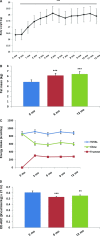Fructose-fed rhesus monkeys: a nonhuman primate model of insulin resistance, metabolic syndrome, and type 2 diabetes
- PMID: 21884510
- PMCID: PMC3170136
- DOI: 10.1111/j.1752-8062.2011.00298.x
Fructose-fed rhesus monkeys: a nonhuman primate model of insulin resistance, metabolic syndrome, and type 2 diabetes
Abstract
The incidence of insulin resistance has increased dramatically over the past several years, and we and others have proposed that this increase may at least in part be attributable to increased dietary fructose consumption. However, a major limitation to the study of diet-induced insulin resistance is the lack of relevant animal models. Numerous studies, mostly in rodents, have demonstrated that diets high in fructose induce insulin resistance; however, important metabolic differences exist between rodents and primates. Thus, the results of metabolic studies performed in primates are substantively more translatable to human physiology, underscoring the importance of establishing nonhuman primate models of common metabolic conditions. In this report, we demonstrate that a high-fructose diet in rhesus monkeys produces insulin resistance and many features of the metabolic syndrome, including central obesity, dyslipidemia, and inflammation within a short period of time; moreover, a subset of monkeys developed type 2 diabetes. Given the rapidity with which the metabolic changes occur, and the ability to control for many factors that cannot be controlled for in humans, fructose feeding in rhesus monkeys represents a practical and efficient model system in which to investigate the pathogenesis, prevention, and treatment of diet-induced insulin resistance and its related comorbidities.
© 2011 Wiley Periodicals, Inc.
Figures


Similar articles
-
Fish oil supplementation ameliorates fructose-induced hypertriglyceridemia and insulin resistance in adult male rhesus macaques.J Nutr. 2014 Jan;144(1):5-11. doi: 10.3945/jn.113.178061. Epub 2013 Oct 9. J Nutr. 2014. PMID: 24108131 Free PMC article.
-
Dioscoreophyllum cumminsii (Stapf) Diels leaves halt high-fructose induced metabolic syndrome: Hyperglycemia, insulin resistance, inflammation and oxidative stress.J Ethnopharmacol. 2016 Nov 4;192:471-479. doi: 10.1016/j.jep.2016.08.024. Epub 2016 Aug 26. J Ethnopharmacol. 2016. PMID: 27568876
-
Plasma sphingolipids are biomarkers of metabolic syndrome in non-human primates maintained on a Western-style diet.Int J Obes (Lond). 2013 Aug;37(8):1064-70. doi: 10.1038/ijo.2012.191. Epub 2012 Dec 4. Int J Obes (Lond). 2013. PMID: 23207405 Free PMC article.
-
Endocrine and metabolic effects of consuming beverages sweetened with fructose, glucose, sucrose, or high-fructose corn syrup.Am J Clin Nutr. 2008 Dec;88(6):1733S-1737S. doi: 10.3945/ajcn.2008.25825D. Am J Clin Nutr. 2008. PMID: 19064538 Free PMC article. Review.
-
High fructose consumption combined with low dietary magnesium intake may increase the incidence of the metabolic syndrome by inducing inflammation.Magnes Res. 2006 Dec;19(4):237-43. Magnes Res. 2006. PMID: 17402291 Review.
Cited by
-
Chronic oxytocin administration inhibits food intake, increases energy expenditure, and produces weight loss in fructose-fed obese rhesus monkeys.Am J Physiol Regul Integr Comp Physiol. 2015 Mar 1;308(5):R431-8. doi: 10.1152/ajpregu.00441.2014. Epub 2014 Dec 24. Am J Physiol Regul Integr Comp Physiol. 2015. PMID: 25540103 Free PMC article.
-
Current advancement in the preclinical models used for the assessment of diabetic neuropathy.Naunyn Schmiedebergs Arch Pharmacol. 2024 May;397(5):2727-2745. doi: 10.1007/s00210-023-02802-0. Epub 2023 Nov 21. Naunyn Schmiedebergs Arch Pharmacol. 2024. PMID: 37987794 Review.
-
Mitochondrial Dysfunction in the Transition from NASH to HCC.Metabolites. 2019 Oct 16;9(10):233. doi: 10.3390/metabo9100233. Metabolites. 2019. PMID: 31623280 Free PMC article. Review.
-
A Historical Review of Brain Drug Delivery.Pharmaceutics. 2022 Jun 16;14(6):1283. doi: 10.3390/pharmaceutics14061283. Pharmaceutics. 2022. PMID: 35745855 Free PMC article. Review.
-
Estradiol Replacement Timing and Obesogenic Diet Effects on Body Composition and Metabolism in Postmenopausal Macaques.Endocrinology. 2019 Apr 1;160(4):899-914. doi: 10.1210/en.2018-00884. Endocrinology. 2019. PMID: 30753523 Free PMC article.
References
-
- Reaven GM. Role of insulin resistance in human disease. Diabetes 1988; 37: 1595–1607. - PubMed
-
- Reaven GM. Insulin resistance/compensatory hyperinsulinemia, essential hypertension, and cardiovascular disease. J Clin Endocrinol Metab 2003; 88: 2399–2403. - PubMed
-
- Reaven GM. The metabolic syndrome or the insulin resistance syndrome? Different names, different concepts, and different goals. Endocrinol Metab Clin North Am 2004; 33: 283–303. - PubMed
-
- Reaven GM. Compensatory hyperinsulinemia and the development of an atherogenic lipoprotein profile: the price paid to maintain glucose homeostasis in insulin‐resistant individuals. Endocrinol Metab Clin North Am 2005; 34: 49–62. - PubMed
-
- Eckel RH, Grundy SM, Zimmet PZ. The metabolic syndrome. Lancet 2005; 365: 1415–1428. - PubMed
Publication types
MeSH terms
Substances
Grants and funding
LinkOut - more resources
Full Text Sources
Medical
Miscellaneous

